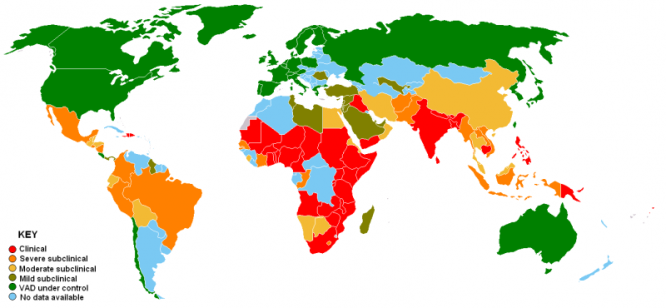Golden Rice
What is Vitamin A?
Before we go into the issues about vitamin A deficiency, maybe we should discuss what exactly vitamin A is and its contribution for allowing the body to function properly. Vitamin A is one of the essential vitamins to humans, meaning that our bodies cannot make the vitamin from other chemicals. As a result, humans have to consume this chemical, in order for this vitamin to aid in the many functions it is used for1:
- Vision
- Gene transcription
- Immune function
- Embryonic development and reproduction
- Bone metabolism
- Skin health
- Antioxidant activity
Vitamin A deficiency
Vitamin A deficiency is a health problem that is particular in specific areas. Developing countries are the largest demographic for this deficiency because of the fact that they cannot intake enough of vitamin A, mostly occurring in Africa and Southeast Asia; children consist of the largest amount of victims of vitamin A deficiency2. The effects of vitamin A deficiency predominantly involve xerophthalmia, which is the drying of the eyes; if prolonged, blindness will occur2. As a result between 250,000 to 500,000 children end up going blind every year, over half end up dying2. Other health problems that occur include skin disorders, infections, diarrhea, and respiratory disorders2.
With vitamin A deficiency becoming such a large health problem in the world, several organizations have taken notice and began to look for solutions. As of 1995, the World Health Organization set a goal to eliminate vitamin A deficiency in developing countries by 20003. Vitamin deficiency was the main topic endorsed by the World Summit for Children, at the International Conference on Nutrition in 19923. Vitamin A deficiency also captured the attention of the World Health Assembly in 19933. These actions and endorsements by world organizations and several foundations, like the Rockefeller foundation, gave the green light for scientists to try and solve the problem of vitamin A deficiency.
With vitamin A deficiency becoming such a large health problem in the world, several organizations have taken notice and began to look for solutions. As of 1995, the World Health Organization set a goal to eliminate vitamin A deficiency in developing countries by 20003. Vitamin deficiency was the main topic endorsed by the World Summit for Children, at the International Conference on Nutrition in 19923. Vitamin A deficiency also captured the attention of the World Health Assembly in 19933. These actions and endorsements by world organizations and several foundations, like the Rockefeller foundation, gave the green light for scientists to try and solve the problem of vitamin A deficiency.
1. Chapter 4: Vitamin A of dietary reference intakes. Food and Nutrition Board of the Institute of Medicine. 2001.
2. Global prevalence of vitamin A deficiency in populations at risk 1995-2005: WHO Global Database on Vitamin A Deficiency. WorldHealth Organization, 2009.
3. Maessen, Jurriaan. “Beyond Golden Rice: The Rockefeller Foundation’s long-term agenda behind Genetically Modified Food”Global Research (6/11/09).Web 15 Mar. 2010 <http://www.globalresearch.ca/index.php?context=va&aid=13944>.
2. Global prevalence of vitamin A deficiency in populations at risk 1995-2005: WHO Global Database on Vitamin A Deficiency. WorldHealth Organization, 2009.
3. Maessen, Jurriaan. “Beyond Golden Rice: The Rockefeller Foundation’s long-term agenda behind Genetically Modified Food”Global Research (6/11/09).Web 15 Mar. 2010 <http://www.globalresearch.ca/index.php?context=va&aid=13944>.


